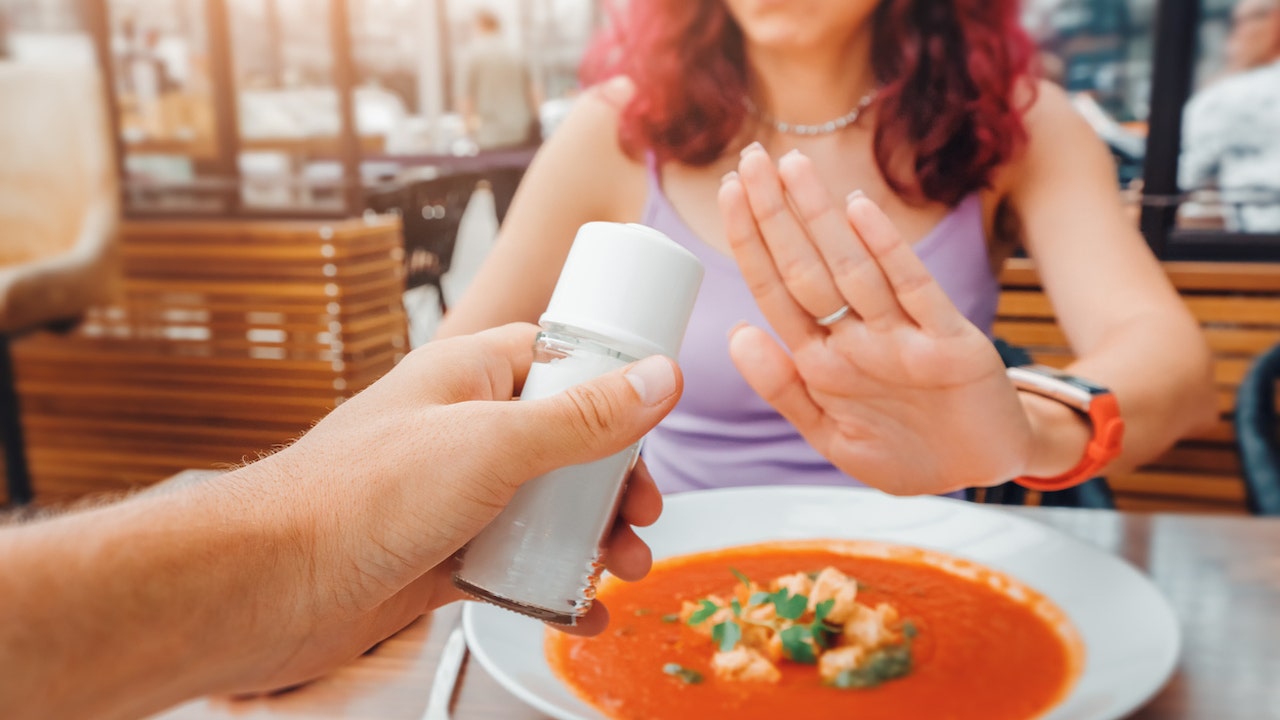Health
Skipping the salt can reduce heart disease risk by almost 20%, study finds: ‘Know what you are consuming’

Skipping the salt could slash heart disease risk by nearly 20%, according to research presented at the annual meeting of the European Society of Cardiology, which was held in Amsterdam this week.
Those who never add salt to their food had an 18% lower risk of being diagnosed with atrial fibrillation — also known as irregular heartbeat or arrhythmia — compared to those who added salt to every meal, researchers from Kyungpook National University Hospital, South Korea, discovered.
If it goes untreated, atrial fibrillation can cause life-threatening conditions including stroke, heart failure and blood clots.
DAILY ASPIRIN AFTER A HEART ATTACK CAN REDUCE THE RISK OF FUTURE EVENTS, STUDY FINDS
The researchers analyzed data from the UK Biobank, which includes more than 500,000 participants in the U.K. between the ages of 40 and 70.
They excluded people who had already had heart disease, heart failure, stroke or atrial fibrillation.
Skipping the salt could slash heart disease risk by nearly 20%, according to research presented this week at the annual meeting of the European Society of Cardiology. (iStock)
All of the participants indicated how frequently they added salt to meals, with the choices including “never/rarely,” “sometimes,” “usually” and “always.”
The research team then followed the groups for a period of 11 years.
Those who switched from always salting their foods to never salting them saw an 18% reduction in risk.
‘LAUGHTER THERAPY’ IS SHOWN TO REDUCE HEART DISEASE RISK IN BRAZILIAN STUDY: ‘EXCITING TO SEE’
People who sometimes added salt saw a 15% lower chance of developing heart issues.
Even those who usually salted their foods saw a 12% reduced risk compared to those who always used salt.
Negative impacts of salt
Briana Costello, M.D., an interventional and general cardiologist at the Texas Heart Institute Center for Cardiovascular Care, noted that she was not surprised by the study’s findings.
Costello was not involved in the study.

Those who never added salt to their food had an 18% lower risk of being diagnosed with atrial fibrillation compared to those who added salt to every meal, according to a new study. (iStock)
“It is well-known that salt does not do anyone favors in regard to cardiovascular health,” she told Fox News Digital.
Costello pointed to a 2021 study that was published in the New England Journal of Medicine. It found that among people who had a history of stroke or were 60 and older with high blood pressure, the rates of stroke, heart issues and death were lower when using a salt substitute compared to using regular salt.
“Salt increases your body’s water retention and can increase blood pressure, which is a leading cause of cardiovascular disease.”
“Where there is salt, there is water,” Costello said. “Salt increases your body’s water retention and can increase blood pressure, which is a leading cause of cardiovascular disease.”
Ronald Freudenberger, M.D., a cardiologist at Lehigh Valley Heart and Vascular Institute in Pennsylvania, who was not involved in the study, warned that salt causes the body to retain fluid.

A 2021 study in the New England Journal of Medicine found that the rates of stroke, heart issues and death were lower when using a salt substitute compared to using regular salt. (iStock)
“It pulls fluid from your body tissues into your bloodstream,” he told Fox News Digital. “That makes your heart do more work because there’s more fluid to pump around your body — and that increases blood pressure.”
This is particularly dangerous for people who already have cardiovascular issues, the doctor said.
ASK A DOC: ‘HOW CAN I PREVENT HIGH CHOLESTEROL?’
“As we age, our blood vessels and heart become less flexible,” Freudenberger said. “If you can imagine having more fluid to pump around in blood vessels that are stiffer, and through a heart that is stiffer, that’s going to put strain on your heart.”
If the blood vessels or heart have a tough time accommodating that extra fluid, it can result in problems such as high blood pressure or atrial fibrillation, the doctor said.
Tips for slashing salt intake
The U.S. Food and Drug Administration (FDA) recommends a daily sodium intake of less than 2,300 mg per day, which is equivalent to around 1 teaspoon of table salt.
Americans consume considerably more than that, however — averaging about 3,400 mg of sodium per day.

To mitigate the risk factors of dietary salt consumption, the experts recommend avoiding adding salt to foods — particularly for those who already have hypertension or have had heart failure. (iStock)
To mitigate the risk factors of dietary salt consumption, the experts recommend avoiding adding salt to foods — particularly for those who already have hypertension or have had heart failure.
Beyond adding table salt, processed foods can be a big source of hidden salt, Costello said.
REGULAR SUGAR VS. ARTIFICIAL SWEETENER: IS ONE WORSE FOR YOU THAN ANOTHER? EXPERTS CHIME IN
“Most people do not realize how much sodium is added in ready-made food,” she said. “The first step is to know what you are already consuming so you can make necessary lifestyle changes.”
Other hidden sources of salt include desserts, pastries and bread, noted Antonette Hardie, a registered dietitian at The Ohio State University Wexner Medical Center.

Hidden sources of salt include desserts, pastries and bread, warned Antonette Hardie, a registered dietitian at The Ohio State University Wexner Medical Center. (iStock)
“Salt is chemically necessary in baked goods for them to bake properly; however, some baked goods are higher in salt for them to taste sweeter,” she told Fox News Digital.
Another hidden source of salt is diet drinks.
“Again, salt makes things taste sweeter, so when salt is added to diet drinks, it makes them more palatable to consumers,” Hardie noted.
CLICK HERE TO SIGN UP FOR OUR HEALTH NEWSLETTER
It’s important to look carefully at the sodium content in the food you eat, noted Freudenberger.
“Even things branded low sodium are more accurately called ‘lower sodium,’ because even they sometimes have a significant amount of sodium,” he told Fox News Digital.

For those who really need a “salt kick,” one cardiologist recommended using a salt substitute as a low-sodium alternative. “There are many spices that can give you the flavor you want, without the sodium, such as onion powder, paprika, rosemary, sage and thyme,” he said. (iStock)
“Sometimes there is 1,000 mg of sodium in a can of low-sodium soup, and that’s all you should have in a day if you have high blood pressure.”
For those who really need a “salt kick,” Freudenberger recommended using a salt substitute as a low-sodium alternative.
“There are many spices that can give you the flavor you want without the sodium, such as onion powder, paprika, rosemary, sage and thyme,” he said.
“Examine salt substitute labels carefully, because many substitutes contain potassium, and too much of that can also be dangerous,” the doctor warned.

Health
Dr: Tirzepatide May Be Even Better Than Ozempic for Weight Loss

Use left and right arrow keys to navigate between menu items.
Use escape to exit the menu.
Sign Up
Create a free account to access exclusive content, play games, solve puzzles, test your pop-culture knowledge and receive special offers.
Already have an account? Login
Health
Former MLB pitcher finds liver donor in high-school classmate he hadn't seen in 20 years

NEWYou can now listen to Fox News articles!
A man’s Facebook plea for a liver donor attracted the attention of a high-school acquaintance he hadn’t spoken to in 20 years.
In April 2024, after experiencing appetite loss and losing 15 pounds in a month, Steven Register, 42, was diagnosed with stage 4 colon cancer, according to news agency SWNS.
Doctors told the former MLB pitcher — who played for the Colorado Rockies in 2008 and the Philadelphia Phillies in 2009 — that a liver transplant was likely his best chance of survival.
MAN WITH STAGE 4 CANCER RAISES $150K FOR EXPERIMENTAL TREATMENT
“When we first met with the doctors, they gave me a year to a year-and-a-half to live,” Register said, adding that he and his wife, Beth, immediately started researching options.
The couple traveled from Auburn, Alabama, to the MD Anderson Cancer Center in Houston, Texas, where Register underwent surgery for a temporary ostomy bag and began chemotherapy, per the SWNS report.
“When we first met with the doctors, they gave me a year to a year-and-a-half to live,” said Steven Register, shown above with his wife, Beth. (SWNS)
Plans for the liver resection were canceled when doctors discovered the tumors were too large, which led the couple to consider a transplant.
Register’s wife created a Facebook group to search for a living liver donor, hoping someone would come forward in time.
An unexpected volunteer
Kristin Johnston, a 40-year-old preschool teacher from Roswell, Georgia, saw the post and recognized Register as a former high-school classmate.
The two had met in 1999 at Shaw High School in Columbus, Georgia, but hadn’t spoken in over two decades.
ALCOHOL-RELATED LIVER TRANSPLANTS ON THE RISE AMONG YOUNG ADULTS, DOCTOR SAYS
“It was just so far out of left field,” said Register, who couldn’t believe it when Johnston volunteered to donate part of her liver.
He added to SWNS, “I haven’t seen or talked to her in over 20 years, and for her to reach out like that, it was just meant to be.”

Kristin Johnston, a 40-year-old preschool teacher from Roswell, Georgia, shown above, saw Register’s Facebook post and recognized him as a former high-school classmate. (SWNS)
Johnston said she started by doing a quick online search for live liver donation and discovered that blood type compatibility was the first step.
“I just sent him a message,” she said. “I said, ‘Hey, what’s your blood type?’ and he said, ‘I’m B positive.’”
She responded, “Wait, that’s mine, too,” and offered, “I’ll happily donate a lobe if I’m a match.”
HIV-POSITIVE TRANSPLANTS NOW PERMITTED FOR LIVERS AND KIDNEYS
Johnston was later cleared as a match and received the confirmation on a meaningful day.
“I got the news on Good Friday, of all days, that I was officially cleared as his liver donor,” she said.
Surgery and second chances
The surgery, which is expected to take 12 to 14 hours, will involve removing 70% of Johnston’s liver and transplanting it into Register, according to SWNS.
Both her remaining liver and the donated portion will regenerate over time, giving both a second chance at health.
“I got the news on Good Friday, of all days.”
“For her, she is ultimately giving him the gift of life — for him, a really fresh start in this journey,” said Beth Register.
CLICK HERE TO SIGN UP FOR OUR HEALTH NEWSLETTER
Steven Register said he hoped that “once I get my liver with all the tumor and cancer out, I’ll be cancer-free from there.”
The Register family — including children McKenzie (16), Blakely (14) and Brooks (8) — launched a fundraiser on SupportNow to help with travel, food and medical expenses.
For more Health articles, visit www.foxnews.com/health
Johnston and her husband Cody, 38, a real estate developer, have three kids of their own — Sawyer (9), Teddy (7) and Dahlia (4).
Raising awareness and faith
Beth Register said she hopes their family’s story raises awareness about the impact of living organ donation.
“A lot of people don’t realize that live donations, whether it be for livers or kidneys, are even an option,” she said.

The Register family — Steven, Beth and their three children, McKenzie (middle-left), Blakely (middle-right) and Brooks (front, center) — launched a fundraiser on SupportNow to help with travel, food and medical expenses. (SWNS)
She added that Johnston had been selfless from the start.
The families believe fate had a hand in reconnecting them, per SWNS.
“We just pray that God is opening all the right doors and that Kristin is the perfect donor for him.”
“We just pray that God is opening all the right doors and that Kristin is the perfect donor for him,” Beth Register said.
“We just appreciate her being willing to put her life on pause to hopefully lengthen his life by many, many, many years.”
Health
Meghan Trainor Swaps Lyrics After Weight Loss + Opens up About Mounjaro

Use left and right arrow keys to navigate between menu items.
Use escape to exit the menu.
Sign Up
Create a free account to access exclusive content, play games, solve puzzles, test your pop-culture knowledge and receive special offers.
Already have an account? Login
-

 News1 week ago
News1 week agoVideo: Faizan Zaki Wins Spelling Bee
-

 Politics1 week ago
Politics1 week agoMichelle Obama facing backlash over claim about women's reproductive health
-

 Technology1 week ago
Technology1 week agoOpenAI wants ChatGPT to be a ‘super assistant’ for every part of your life
-

 Technology1 week ago
Technology1 week agoSEC drops Binance lawsuit in yet another gift to crypto
-

 Movie Reviews1 week ago
Movie Reviews1 week agoThe Verdict Movie Review: When manipulation meets its match
-

 Technology1 week ago
Technology1 week agoWhy do SpaceX rockets keep exploding?
-

 World1 week ago
World1 week agoTwo killed in Russian attacks on Ukraine before possible talks in Turkiye
-

 News1 week ago
News1 week agoOil companies face a wrongful death suit tied to climate change


















